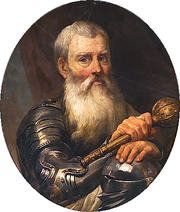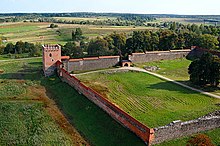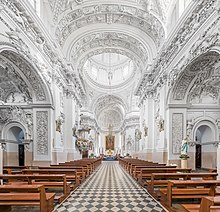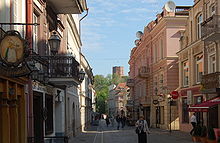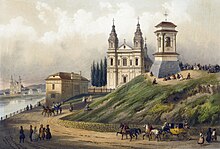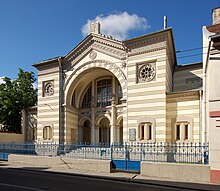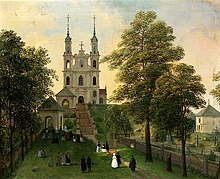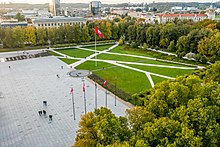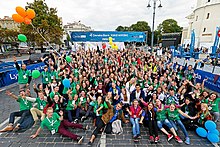Vilnius
Vilnius is notable for the architecture of its Old Town, considered one of Europe's largest and best-preserved old towns. The city was declared a UNESCO World Heritage Site in 1994. The architectural style known as Vilnian Baroque is named after the city, which is farthest to the east among Baroque cities and the largest such city north of the Alps.
The city was noted for its multicultural population during the Polish–Lithuanian Commonwealth, with contemporary sources comparing it to Babylon. Before World War II and the Holocaust, Vilnius was one of Europe's most important Jewish centers. Its Jewish influence has led to its being called "the Jerusalem of Lithuania", and Napoleon called it "the Jerusalem of the North" when he passed through in 1812.
Vilnius was a 2009 European Capital of Culture with Linz in Austria. In 2021, the city was named one of fDi's 25 Global Cities of the Future. Vilnius is considered a global financial centre, ranked 76th globally and 29th in Europe on the Global Financial Centres Index. The city is an important center for the global fintech industry. It hosted the 2023 NATO Summit. In 2025 Vilnius was the European Green Capital. Vilnius is a member of Eurocities and the Union of Capitals of the European Union (UCEU).
Etymology and other names
Vilnius' name originates from the river Vilnia, the Lithuanian word for ripple. Its name has had a number of derivative spellings in various languages throughout its history; Vilna was once common in English. The most notable non-Lithuanian names for the city include Latin: Vilna, Polish: Wilno, Belarusian: Вiльня (Vilnia), German: Wilna, Latvian: Viļņa, Ukrainian: Вільно (Vilno), Yiddish: ווילנע (Vilne). A Russian name dating to the Russian Empire was Вильна (Vilna), although Вильнюс (Vilnyus) is now used. The names Wilno, Wilna, and Vilna were used in English-, German-, French-, and Italian-language publications when the city was a capital of the Polish–Lithuanian Commonwealth and an important city in the Second Polish Republic. The name Vilna is still used in Finnish, Portuguese, Spanish, and Hebrew: וילנה. Wilna is still used in German alongside Vilnius.

According to a legend recorded during the c. 1530s, Grand Duke Gediminas (c. 1275–1341) was hunting in the sacred forest near Šventaragis' Valley, (where the Vilnia flows into the river Neris. The successful wisent hunt lasted longer than expected, and Gediminas decided to spend the night in the valley. He fell asleep and dreamed of a huge Iron Wolf at the top of a hill, howling loudly. Upon awakening, the Duke asked the krivis Lizdeika to interpret the dream. The chief priest told him:
What is destined for the ruler and the State of Lithuania, is thus: the Iron Wolf represents a castle and a city which will be established by you on this site. This city will be the capital of the Lithuanian lands and the dwelling of their rulers, and the glory of their deeds shall echo throughout the world.
Gediminas, obeying the gods, built two castles: the Lower Castle in the valley, and the Crooked Castle on Bald Hill. He moved his court there, declared it his permanent seat and capital, and developed the surrounding area into a city he named Vilnius.
History

Vilnius' history dates to the Stone Age. The city has been ruled by imperial and Soviet Russia, Napoleonic France, imperial and Nazi Germany, interwar Poland, and Lithuania.
Initially a Baltic settlement, Vilnius became significant in the Grand Duchy of Lithuania. The city was first mentioned in letters by Grand Duke Gediminas, who invited Jews and Germans to settle and built a wooden castle on a hill. Vilnius became a city in 1387, after the Christianization of Lithuania, and was settled by craftsmen and merchants of a variety of nationalities. It was the capital of the Grand Duchy (until 1795), and of the Polish–Lithuanian Commonwealth. Vilnius flourished under the commonwealth, especially after the 1579 establishment of Vilnius University by King Stephen Báthory. The city became a cultural and scientific center, attracting migrants from east and west. It had diverse communities, with Jewish, Orthodox, and German populations. The city experienced a number of invasions and occupations, including by the Teutonic Knights, Russia and, later, Germany.
Under imperial Russian rule, Vilnius became the capital of Vilna Governorate and had a number of cultural revivals during the 19th and early 20th centuries by Jews, Poles, Lithuanians, and Belarusians. After World War I, the city experienced conflict between Poland and Lithuania which led to its occupation by Poland before its annexation by the Soviet Union during World War II. After that war, Vilnius became the capital of the Lithuanian Soviet Socialist Republic.
Independence
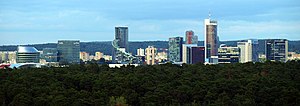
On 11 March 1990, the Supreme Council of the Lithuanian SSR announced its secession from the Soviet Union and intention to restore an independent Lithuania. On 9 January 1991, the Soviet Union sent in troops; this culminated in the 13 January attack on the State Radio and Television Building and Vilnius TV Tower which killed 14 civilians. The Soviet Union recognised Lithuanian independence in September 1991. According to the Constitution of Lithuania, "the capital of the State of Lithuania shall be the city of Vilnius, the long-standing historical capital of Lithuania".

Vilnius has become a modern European city. Its territory has been expanded with three acts since 1990, incorporating urban areas, villages, hamlets, and the city of Grigiškės. Most historic buildings have been renovated and a business and commercial area became the New City Centre, the main administrative and business district on the north side of the river Neris. The area includes modern residential and retail space, with the municipal building and the 148.3 m (487 ft) Europa Tower its most prominent buildings. The construction of Swedbank's headquarters indicates the importance of Scandinavian banks in Vilnius. The Vilnius Business Harbour complex was built and expanded. Over 75,000 flats were built from 1995 to 2018, making the city a Baltic construction leader.

Vilnius was selected as a 2009 European Capital of Culture with Linz, the capital of Upper Austria. The 2007–2008 financial crisis led to a drop in tourism, which prevented many projects from completion; allegations of corruption and incompetence were made; tax increases for cultural activity led to protests, and economic conditions sparked riots. On 28–29 November 2013, Vilnius hosted the Eastern Partnership summit at the Palace of the Grand Dukes of Lithuania. Many European presidents, prime ministers, and high-ranking officials participated. In 2015, Remigijus Šimašius became the city's first directly elected mayor. The 2023 NATO summit was held in Vilnius.
Geography

Vilnius is at the confluence of the Vilnia and Neris rivers in southeastern Lithuania. Several countries say that the geographical midpoint of Europe is within their territory. The midpoint depends on the definition of European extent, and the Guinness Book of World Records recognises a point near Vilnius as the continental centre. After a 1989 re-estimation of European boundaries, Jean-George Affholder of the Institut Géographique National (French National Geographic Institute) determined that its geographic centre was at 54°54′N 25°19′E / 54.900°N 25.317°E. The method used to calculate the point was the centre of gravity of the European geometrical figure, and is near the village of Girija (26 kilometres from Vilnius). A monument by sculptor Gediminas Jokūbonis, a column of white granite surmounted by a crown of stars, was built there in 2004.
Vilnius is 312 km (194 mi) from the Baltic Sea and Klaipėda, the main Lithuanian seaport. It is connected by road to other major Lithuanian cities, such as Kaunas (102 km or 63 mi away), Šiauliai (214 km or 133 mi away) and Panevėžys (135 km or 84 mi away).
Vilnius has an area of 402 km (155 sq mi). Buildings cover 29.1 percent of the city; green space covers 68.8 percent, and water covers 2.1 percent. The city has eight nature reserves: Vokės Senslėnio Slopes Geomorphological Reserve, Aukštagiris Geomorphological Reserve, Valakupių Klonio Geomorphological Reserve, Veržuva Hydrographic Reserve, Vokė Hydrographic Reserve, Cedronas Upstream Landscape Reserve, Tapeliai Landscape Reserve, and Šeškinė Slopes Geomorphological Reserve.
Several lakes, including Balžis, are located on the north-eastern outskirts of Vilnius.
Climate

Vilnius has a humid continental climate (Köppen climate classification Dfb), with temperature records since 1777. The average annual temperature is 7.3 °C (45 °F); the average January temperature is −3.9 °C (25 °F), and the July average is 18.7 °C (66 °F). Average annual precipitation is 691 mm (27.20 in). Temperatures in the city have increased significantly during the last 30 years, a change which the Lithuanian Hydrometeorological Service attributes to human-induced global warming.
Summer days are warm to hot, especially in July and August, with daytime temperatures above 30 °C (86 °F) during periodic heat waves. Outdoor bars, restaurants and cafés are frequented during the day.
Winters can be very cold, although temperatures above 0 °C (32 °F); still occasionally occur. Temperatures below −25 °C (−13 °F) are recorded every other year. Vilnius's rivers freeze in particularly cold winters, and the lakes surrounding the city are almost always frozen from December to March, and even April, in the most extreme years. The Lithuanian Hydrometeorological Service, headquartered in Vilnius, monitors the country's climate.
| Climate data for Vilnius (1991–2020 normals, sun 1961–1990, extremes 1777–present) | |||||||||||||
|---|---|---|---|---|---|---|---|---|---|---|---|---|---|
| Month | Jan | Feb | Mar | Apr | May | Jun | Jul | Aug | Sep | Oct | Nov | Dec | Year |
| Record high °C (°F) | 12.3 (54.1) |
14.4 (57.9) |
24.7 (76.5) |
29.0 (84.2) |
31.8 (89.2) |
34.2 (93.6) |
36.4 (97.5) |
34.9 (94.8) |
33.1 (91.6) |
24.5 (76.1) |
15.5 (59.9) |
10.5 (50.9) |
36.4 (97.5) |
| Mean maximum °C (°F) | 4.9 (40.8) |
5.7 (42.3) |
13.1 (55.6) |
22.4 (72.3) |
26.7 (80.1) |
28.8 (83.8) |
30.8 (87.4) |
30.3 (86.5) |
25.4 (77.7) |
18.3 (64.9) |
11.1 (52.0) |
6.1 (43.0) |
32.1 (89.8) |
| Mean daily maximum °C (°F) | −1.7 (28.9) |
−0.5 (31.1) |
4.4 (39.9) |
12.6 (54.7) |
18.4 (65.1) |
21.7 (71.1) |
23.8 (74.8) |
23.1 (73.6) |
17.4 (63.3) |
10.3 (50.5) |
3.7 (38.7) |
−0.3 (31.5) |
11.1 (52.0) |
| Daily mean °C (°F) | −3.8 (25.2) |
−3.1 (26.4) |
0.9 (33.6) |
7.6 (45.7) |
13.0 (55.4) |
16.4 (61.5) |
18.7 (65.7) |
17.9 (64.2) |
13.0 (55.4) |
7.1 (44.8) |
1.9 (35.4) |
−2.1 (28.2) |
7.3 (45.1) |
| Mean daily minimum °C (°F) | −5.9 (21.4) |
−5.6 (21.9) |
−2.7 (27.1) |
2.6 (36.7) |
7.5 (45.5) |
11.1 (52.0) |
13.6 (56.5) |
12.7 (54.9) |
8.5 (47.3) |
3.9 (39.0) |
0.0 (32.0) |
−4 (25) |
3.5 (38.3) |
| Mean minimum °C (°F) | −19.3 (−2.7) |
−17.5 (0.5) |
−10.8 (12.6) |
−4.2 (24.4) |
0.1 (32.2) |
4.9 (40.8) |
8.1 (46.6) |
6.8 (44.2) |
1.1 (34.0) |
−3.8 (25.2) |
−8.7 (16.3) |
−14.1 (6.6) |
−22.0 (−7.6) |
| Record low °C (°F) | −37.2 (−35.0) |
−35.8 (−32.4) |
−29.6 (−21.3) |
−14.4 (6.1) |
−4.4 (24.1) |
0.1 (32.2) |
3.5 (38.3) |
1.0 (33.8) |
−4.8 (23.4) |
−14.4 (6.1) |
−22.8 (−9.0) |
−30.5 (−22.9) |
−37.2 (−35.0) |
| Average precipitation mm (inches) | 38.9 (1.53) |
34.4 (1.35) |
37.0 (1.46) |
46.2 (1.82) |
52.1 (2.05) |
72.7 (2.86) |
79.3 (3.12) |
75.8 (2.98) |
65.2 (2.57) |
51.5 (2.03) |
51.5 (2.03) |
49.2 (1.94) |
653.8 (25.74) |
| Average precipitation days | 21.7 | 18.4 | 17.5 | 10.2 | 12.4 | 11.7 | 11.4 | 10.5 | 9.7 | 13.5 | 16.7 | 21.2 | 174.9 |
| Average dew point °C (°F) | −5 (23) |
−5 (23) |
−3 (27) |
1 (34) |
6 (43) |
10 (50) |
13 (55) |
12 (54) |
9 (48) |
4 (39) |
0 (32) |
−3 (27) |
3 (38) |
| Mean monthly sunshine hours | 37 | 70 | 117 | 165 | 242 | 231 | 220 | 217 | 141 | 93 | 33 | 25 | 1,591 |
| Average ultraviolet index | 0 | 1 | 2 | 3 | 5 | 6 | 6 | 5 | 3 | 2 | 1 | 0 | 3 |
| Source: WMO (avg high and low) NOAA (sun, extremes), Météo Climat, Time and Date (dewpoints, 1985–2015) and Weather Atlas | |||||||||||||
Culture
Painting and sculpture


Vilnius was an artistic centre of the Grand Duchy of Lithuania, attracting artists across Europe. The oldest surviving early Gothic artworks (14th century) are paintings dedicated to churches and liturgy, such as frescoes in the crypts of Vilnius Cathedral and decorated hymnbooks. Sixteenth-century wall paintings are in the city's Church of St. Francis and St. Bernard and the Church of Saint Nicholas. Gothic wooden polychrome sculptures decorate church altars. Some Gothic seals from the 14th and 15th centuries still exist, including those of Kęstutis, Vytautas the Great and Sigismund II Augustus.
Renaissance sculpture appeared during the early 16th century, primarily by the Italian sculptors Bernardinus Zanobi da Gianotti, Giovani Cini, and Giovanni Maria Padovano. During the Renaissance, portrait tombstones and medals were valued; examples are the marble tombs of Albertas Goštautas (1548) and Paweł Holszański (1555) by Bernardino de Gianotis in Vilnius Cathedral. Italian sculpture is characterized by its naturalistic treatment of forms and precise proportions. Local sculptors adopted the iconographic scheme of Renaissance tombs; their works, such the tomb of Lew Sapieha (c. 1633) in the Church of St. Michael, are stylized. During this period, local and Western European painters created religious and mythological compositions and portraits with late Gothic and Baroque features; illustrated prayerbooks, illustrations, and miniatures have survived.
During the late-16th-century Baroque, wall painting developed. Most palaces and churches were decorated in frescoes with bright colors, sophisticated angles, and drama. Secular painting – representational, imaginative, epitaph portraits, scenes of battles and politically important events in a detailed, realistic style – also spread at this time. Baroque sculptures dominated sacred architecture: tombstones with sculpted portraits and decorative sculptures in wood, marble, and stucco. Italian sculptors such as G. P. Perti, G. M. Galli, and A. S. Capone, key figures in the development of sculpture in the 17th-century grand duchy, were commissioned by Lithuanian nobility. Their works exemplify the mature Baroque, with expressive forms and sensuality. Local sculptors emphasized Baroque decorative features, with less expression and emotion.

Lithuanian painting was influenced by the Vilnius Art School during the late 18th and 19th centuries, which introduced classical and romantic art. Painters had internships abroad, mainly in Italy. Allegorical, mythological compositions, landscapes, and portraits of representatives of various circles of society began, and historical themes prevailed. The era's best-known classical painters are Franciszek Smaglewicz, Jan Rustem, Józef Oleszkiew, Daniel Kondratowicz, Józef Peszka, and Wincenty Smokowski. Romantic artists were Jan Rustem, Jan Krzysztof Damel, Wincenty Dmochowski and Kanuty Rusiecki. After the 1832 closure of Vilnius University, the Vilnius Art School continued to influence Lithuanian art.
The Lithuanian Art Society was established in 1907 by Petras Rimša, Antanas Žmuidzinavičius and Antanas Jaroševičius, and the Vilnius Art Society was founded the following year. Artists included Jonas Šileika, Justinas Vienožinskis, Jonas Mackevičius (1872), Vytautas Kairiūkštis, and Vytautas Pranas Bičiūnas, who employed Western European symbolism, realism, Art Nouveau and modernism. Socialist realism was introduced after World War II, with propaganda paintings, historical and household works, still lives, landscapes, portraits, and sculptures. Late 20th- and 21st-century painters are Žygimantas Augustinas, Eglė Ridikaitė, Eglė Gineitytė, Patricija Jurkšaitytė, Jurga Barilaitė, and Solomonas Teitelbaumas.
The Užupis district near the Old Town, a run-down district during the Soviet era, hosts bohemian artists who operate a number of art galleries and workshops. In its main square, a statue of an angel blowing a trumpet symbolises artistic freedom.
The world's first bronze memorial to Frank Zappa was installed in the Naujamiestis district in 1995. In 2015, the Vilnius Talking Statues project was introduced. Eighteen statues around the city interact by smartphone with visitors in several languages.
Museums and galleries

Vilnius has a variety of museums. The National Museum of Lithuania, in the Palace of the Grand Dukes of Lithuania, Gediminas' Tower and the arsenals of the Vilnius Castle Complex, has exhibits about the history of Lithuania and Lithuanian culture. The Museum of Applied Arts and Design displays Lithuanian folk and religious art, objects from the Palace of the Grand Dukes of Lithuania, and 18th- to 20th-century clothing. Other museums are the Vilnius Museum, the House of Histories, Church Heritage Museum, Museum of Occupations and Freedom Fights, Fight for Freedom Museum in the Vilnius TV Tower, M. K. Čiurlionis House, Samuel Bak Museum, Centre for Civil Education, Toy Museum, Vilnil (Museum of Illusions), Energy and Technology Museum, House of Signatories, Tolerance Center, Railway Museum, Money Museum, Kazys Varnelis House-Museum, Liubavas Manor Watermill-Museum, Museum of Vladislovas Sirokomlė, Amber Museum-Gallery, and the Paneriai Memorial visitor information centre.

Vilnius has a number of art galleries. Lithuania's largest art collection is housed in the Lithuanian National Museum of Art. The Vilnius Picture Gallery, in the city's Old Town, houses a collection of Lithuanian art from the 16th to the early 20th centuries. Across the Neris, the National Art Gallery has a number of exhibitions of 20th-century Lithuanian art. The Contemporary Art Centre, the largest contemporary-art venue in the Baltic States, has an exhibition space of 2,400 square metres (26,000 sq ft). The centre develops international and Lithuanian exhibitions and presents a range of public programs which include lectures, seminars, performances, film and video screenings, and live music. On 10 November 2007, the Jonas Mekas Visual Arts Center was opened by avant-garde filmmaker Jonas Mekas; its premiere exhibition was The Avant-Garde: From Futurism to Fluxus. In 2018, the MO Museum opened as an initiative of Lithuanian scientists and philanthropists Danguolė and Viktoras Butkus. Its collection of 5,000 modern pieces includes major Lithuanian artworks from the 1950s to the present.
Literature

Around 1520, Francysk Skaryna (author of the first Ruthenian Bible) established eastern Europe's first printing house in Vilnius. Skaryna prepared and published the Little Traveller's Book (Ruthenian: Малая подорожная книжка), the first printed book of the Grand Duchy of Lithuania, in 1522. Three years later, he printed the Acts and Epistles of the Apostles (the Apostle).
The Vilnius Academy Press was established in 1575 by Lithuanian nobleman Mikołaj Krzysztof "the Orphan" Radziwiłł as the Vilnius Academy printing house, delegating its management to the Jesuits. It published its first book, Piotr Skarga's Pro Sacratissima Eucharistia contra haeresim Zwinglianam, in May 1576. The press was funded by the Lithuanian nobility and the church. In 1805, Józef Zawadzki bought the press and founded the Józef Zawadzki printing shop. Operating continuously until 1939, it published books in a number of languages; Adam Mickiewicz's first poetry book was published in 1822.
Mikalojus Daukša translated and published a catechism by Spanish Jesuit theologian Jacobo Ledesma in 1595, the first printed Lithuanian-language book in the Grand Duchy of Lithuania. He also translated and published Jakub Wujek's Postilla Catholica in 1599.

Many writers were born in Vilnius, lived there, or are alumni of Vilnius University; they include Konstantinas Sirvydas, Maciej Kazimierz Sarbiewski, Antoni Gorecki, Józef Ignacy Kraszewski, Antoni Edward Odyniec, Michał Józef Römer, Adam Mickiewicz, Władysław Syrokomla, Józef Mackiewicz, Romain Gary, Juliusz Słowacki, Simonas Daukantas, Mykolas Biržiška, Petras Cvirka, Kazys Bradūnas, Nobel laureate Czesław Miłosz). Vilnius Academy of Arts alumnae have also added to the internationally acclaimed contemporary writers such as Jurga Ivanauskaitė, Undinė Radzevičiūtė and Kristina Sabaliauskaitė. The first consideration of the First Statute of Lithuania took place in 1522 at the Seimas of the Grand Duchy of Lithuania. The code was drafted under the guidance of Grand Chancellor of Lithuania Albertas Goštautas in accordance with customary law, legislation, and canon and Roman law. It is Europe's first codification of secular law. Albertas Goštautas supported the use of Lithuanian in literature and protected Lithuanian authors (including Abraomas Kulvietis and Michael the Lithuanian) who criticised the use of Old Church Slavonic, and called refugees Old Believers in De moribus tartarorum, lituanorum et moscorum.

Since the 16th century, the Lithuanian Metrica has been kept at the Lower Castle and safeguarded by the State Chancellor. Due to the deterioration of the books, Grand Chancellor Lew Sapieha ordered the Metrica recopied in 1594; the recopying continued until 1607. The recopied books were inventoried, rechecked, and transferred to a separate building in Vilnius; the older books remained in the Castle of Vilnius. According to 1983 data, 665 books remain on microfilm at the Lithuanian State Historical Archives in Vilnius.
Over 200 tiles and plaques commemorating writers who lived and worked in Vilnius and foreign authors connected to Vilnius and Lithuania adorn walls on Literatų Street (Lithuanian: Literatų gatvė) in the Old Town, outlining the history of Lithuanian literature. The Institute of Lithuanian Literature and Folklore and the Lithuanian Writers' Union are in the city. The Vilnius book fair is held annually at LITEXPO, the Baltics' largest exhibition centre.
Cinema

The first public film session in Vilnius was held in the Botanical Garden (now the Bernardinai Garden) in July 1896. It was held after 1895 film sessions by Auguste and Louis Lumière in Paris. The session in Vilnius showed the Lumière brothers' documentary films. The first films shown were educational, filmed outside Vilnius (in India and Africa), and introduced other cultures. Georges Méliès' film, A Trip to the Moon, was first shown at the Lukiškės Square movie theater in 1902; it was the first feature film shown in Vilnius.
The first movie theater in Vilnius, Iliuzija (Illusion), opened in 1905 at 60 Didžioji Street. The first movie theaters, similar to theatres, had boxes with more-expensive seats. Because early films were silent, showings were accompanied by orchestral performances. Cinema screenings were sometimes combined with theatrical performances and illusion shows.

On 4 June 1924, the Vilnius magistrate established a 1,200-seat movie theater in the city hall (Polish: Miejski kinematograf, City Movie Theater) to provide cultural education for students and adults. In 1926, 502,261 tickets were sold; 24,242 tickets were given to boarding children, 778 to tourists, and 8,385 to soldiers. In 1939, Lithuanian authorities renamed it Milda. The last city government gave it to the People's Commissariat of Education, which established the Lithuanian National Philharmonic Society, the following year.
In 1965, Lithuania's most modern movie theater (Lietuva) opened in Vilnius; it had over 1.84 million visitors per year, and an annual profit of over 1 million roubles. After reconstruction, it had one of Europe's largest screens: 200 square metres (2,200 sq ft). Closed in 2002, it was demolished in 2017 and replaced by MO Museum. Kino Pavasaris is the city's largest film festival. The Lithuanian Film Centre (Lithuanian: Lietuvos kino centras), tasked with promoting the development and competitiveness of the Lithuanian film industry, is in Vilnius.
Music

Musicians performed at the Palace of the Grand Dukes of Lithuania as early as the 14th century, since Grand Duke Gediminas' daughter Aldona of Lithuania was known to be enthusiastic about music. Aldona brought court musicians and singers to Kraków after marrying King Casimir III the Great. During the 16th century, composers such as Wacław of Szamotuły, Jan Brant, Heinrich Finck, Cyprian Bazylik, Alessandro Pesenti, Luca Marenzio, and Michelagnolo Galilei lived in Vilnius; the city was also home to virtuoso lutist Bálint Bakfark. One of the first local musicians in written sources was Steponas Vilnietis (Stephanus de Vylna). The first textbook of Lithuanian music, The Art and Practice of Music (Latin: Ars et praxis musica), was published in Vilnius by Žygimantas Liauksminas in 1667.
Italian artists produced Lithuania's first opera on 4 September 1636 at the Palace of the Grand Dukes, commissioned by Grand Duke Władysław IV Vasa. Operas are produced at the Lithuanian National Opera and Ballet Theatre and by the Vilnius City Opera.
The Lithuanian National Philharmonic Society, the country's largest and oldest state-owned concert organization, produces live concerts and tours in Lithuania and abroad. The Lithuanian State Symphony Orchestra, founded by Gintaras Rinkevičius, performs in Vilnius.
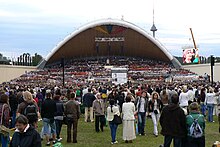
Choral music is popular in Lithuania, and Vilnius has three choir laureates (Brevis, Jauna Muzika, and the Chamber Choir of the Conservatoire) at the European Grand Prix for Choral Singing. The Lithuanian Song and Dance Festival in Vilnius has been presented every four years since 1990 for about 30,000 singers and folk dancers in Vingis Park. In 2008, the festival and its Latvian and Estonian counterparts were designated as a UNESCO Masterpiece of the Oral and Intangible Heritage of Humanity.
The jazz scene is active in Vilnius; in 1970–71, the Ganelin/Tarasov/Chekasin trio founded the Vilnius Jazz School. The Vilnius Jazz Festival is held annually.

The annual Gatvės muzikos diena (Street Music Day) gathers musicians on the city's streets. Vilnius is the birthplace of singers Mariana Korvelytė – Moravskienė, Paulina Rivoli, Danielius Dolskis, Vytautas Kernagis, Algirdas Kaušpėdas, Andrius Mamontovas, Nomeda Kazlaus, and Asmik Grigorian); composers César Cui, Felix Yaniewicz, Maximilian Steinberg, Vytautas Miškinis, and Onutė Narbutaitė); conductor Mirga Gražinytė-Tyla), and musicians Antoni Radziwiłł, Jascha Heifetz, Clara Rockmore, and Romas Lileikis).
It was the hometown of 18th-century composers Michał Kazimierz Ogiński, Johann David Holland (colleague of C. Bach), Maciej Radziwiłł, and Michał Kleofas Ogiński. Nineteenth-century Vilnius was known for singer Kristina Gerhardi Frank, a close friend of Mozart and Haydn (who starred in the premiere of Haydn's Creation), mid-19th century guitar virtuoso Marek Konrad Sokołowski and composer Stanisław Moniuszko. The wealthiest woman in Vilnius during the early 19th century was singer Maria de Neri. In the early 20th century, Vilnius was the hometown of Mikalojus Konstantinas Čiurlionis, Mikas Petrauskas, and Juozas Tallat-Kelpša. Late-20th- and early 21st-century musicians include Vyacheslav Ganelin, Petras Vyšniauskas, Petras Geniušas, Mūza Rubackytė, Alanas Chošnau, and Marijonas Mikutavičius.
The Lithuanian Academy of Music and Theatre, headquartered on Gediminas Avenue, is also located at the Slushko Palace in Antakalnis. Singers who have lectured at the academy include tenors Kipras Petrauskas and Virgilijus Noreika.
Theatre

The Lithuanian Grand Dukes' entertainment at the castle, rulers' visits abroad and guests' meetings had theatrical elements. During Sigismund III Vasa's residence in Vilnius in the early 17th century, English actors performed at the palace. Władysław IV Vasa established a professional opera theatre in the Lower Castle in 1635, where drammas per musica were performed by the Italian Virgilio Puccitelli. The performances had basic, luxurious scenography.
A Jesuit School Theatre existed between the 16th and 18th centuries, with its first performance (Hercules by S. Tucci) in 1570 in Vilnius. Baroque aesthetics prevailed at the theatre, which also had medieval retrospectives, Renaissance elements, Rococo motifs, and an educational function. Performances were in Latin, but elements of the Lithuanian language were included and some of the works had Lithuanian themes (plays dedicated to Algirdas, Mindaugas, Vytautas and other Lithuanian rulers).
Wojciech Bogusławski established Vilnius City Theatre, the city's first public theatre, in 1785. The theatre, initially in the Oskierka Palace, moved to the Radziwiłł Palace and Vilnius Town Hall. Plays were performed in Polish until 1845, from 1845 to 1864 in Polish and Russian, and after 1864 in Russian. After the Lithuanian-language ban was lifted, plays were also performed in Lithuanian. The theatre closed in 1914.

During the interwar period (when the city was part of Poland), Vilnius was known for the modern, experimental Reduta troupe and institute led by Juliusz Osterwa. The Vilnius Lithuanian Stage Amateur Company (Lithuanian: Vilniaus lietuvių scenos mėgėjų kuopa), established in 1930 and renamed Vilnius's Lithuanian Theatre, performed in the region. In 1945, it was merged with the Lithuanian National Drama Theatre.
After the Soviet occupation of Lithuania in 1940, theatre became a means of disseminating Soviet ideology. Performances incorporated socialist realism, and a number of revolutionary plays by Russian authors were staged. A Repertory Commission was established under the Ministry of Culture to direct theatres, control repertoire, and permit (or ban) performances.
Theatre changed after Lithuanian independence. The independent Vilnius City Opera blends classical and contemporary art. The Lithuanian National Drama Theatre, State Small Theatre of Vilnius, State Youth Theatre and a number of private theatre companies (including OKT/Vilnius City Theatre and the Anželika Cholina Dance Theatre) present classical, modern and Lithuanian plays directed by noted Lithuanian and foreign directors. There is also a Russian-language Old Theatre of Vilnius.
Photography

According to the memoirs of architect Bolesław Podczaszyński, published in January 1853 in the Gazeta Warszawska, Lithuanian photography began with the daguerreotyping in the summer of 1839 of the reconstructed Verkiai Palace by François Marcillac (governor of the children of Duke Ludwig Wittgenstein). The country's unfavorable political situation hampered the development of new technology and cultural activities. The first known daguerreotype-portrait atelier in Vilnius was opened in 1843 by C. Ziegler, and ateliers operated in Lithuania until 1859. One of the best-known photographers was K. Neupert, from Norway.
In the 1860s, with the spread of the collodion process, glass negatives and albumen paper were used instead of daguerreotype plates. Photo portraits in standard formats became widespread, and commercial photography ateliers were established in Vilnius and other Lithuanian cities. The first landscape and architectural photographs were made by Vilnius photographers Abdonas Korzonas and Albert Swieykowski, who compiled the 32-image Vilnius Album (Lithuania's first set of photographs). In 1862, Provisional Censorship Regulations governing the activities of photographic institutions were adopted in 1862, supervised by the Central Press Board of the Ministry of the Interior. Those who photographed the rebels in the January Uprising were punished; A. Korzonas was deported to Siberia. Other prominent 19th-century photographers were Stanisław Filibert Fleury (a stereoscopic-photography pioneer), Aleksander Władysław Strauss, and Józef Czechowicz.
The world's second photoheliograph was installed in 1865 at the Vilnius University Astronomical Observatory, and photographed sunspots. An unprecedented system of photographing solar dynamics began in 1868 in Vilnius. Jan Bułhak founded the country's first photography club in Vilnius in 1927. In 1952, Švyturys magazine organized the city's first photography exhibition.


